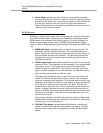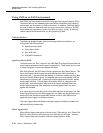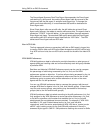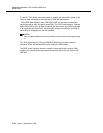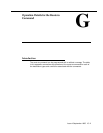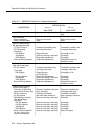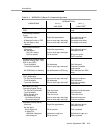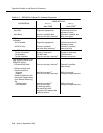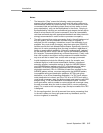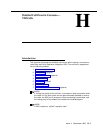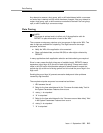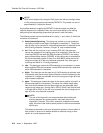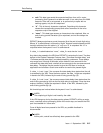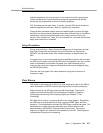
Introduction
Issue 4 September 1995
G-5
Notes:
1
The interaction ‘‘Stop’’ means the following: vector processing is
stopped, the call remains queued to a split, and the caller continues to
hear feedback initiated by a previous step. In the case where the
route-
to
command fails and processing stops (due to a busy station or trunk
group destination), retry can be implemented in the vector. Retrying is
accomplished by including an unconditional
goto
step as the last step to
allow for a loop back to the
route to
command. Use of an intermediate
wait-time
command step with appropriate feedback and delay interval is
strongly recommended in order to reduce processor occupancy.
2
The call is removed from vector processing (that is, the call is taken out of
any split queue, and any feedback, such as music or ringback, is
removed) for
with coverage y
interactions, even if the destination is not
available. Any
route-to with coverage y
step that routes over ISDN-PRI
facilities cancels the Look-Ahead Interflow feature. Specifically, the call is
taken out of vector processing when the step is reached, regardless of
facility or remote switch availability. If the call is subsequently ‘‘rejected’’
by the receiving switch vector, the call is given the treatment defined by
the ‘‘rejection’’ command (either busy or forced disconnect). Finally, note
that a call routed via an
adjunct routing
command is treated the same
way as a call that is routed via a
route-to with coverage y
command.
3
Invalid destinations include the following: empty (for example, zero
collected digits) or invalid
route-to
destination number, unassigned
extension number, incomplete number of digits for AAR/ARS pattern,
non-AAR/ARS feature access code (FAC), maintenance busy station
extension, COR of the VDN that prevents access (for example,
origination restricted), FRL of a VDN that is lower than required for the
AAR/ARS pattern access, no routes assigned to the AAR/ARS pattern,
incompatible calling and destination partitions, ACTGA trunk group
destination, or an off-net forwarding destination. If a TAC (trunk access
code) destination is involved, and if the TAC is for a CO/FX trunk with a
route-to with coverage n
step, the digits entered must match a valid ARS
analysis string. If not, the destination is considered invalid. For other
trunk types with a
route-to number
or
route-to digits with coverage n
step,
the step succeeds when the trunk is seized (that is, vector processing
stops). For a
route-to with coverage y
step, the step succeeds if the TAC
is assigned.
4
On the sending switch, the call is removed from vector processing (that
is, the call is taken out of any split queue and any feedback, such as
music or ringback, is removed).



